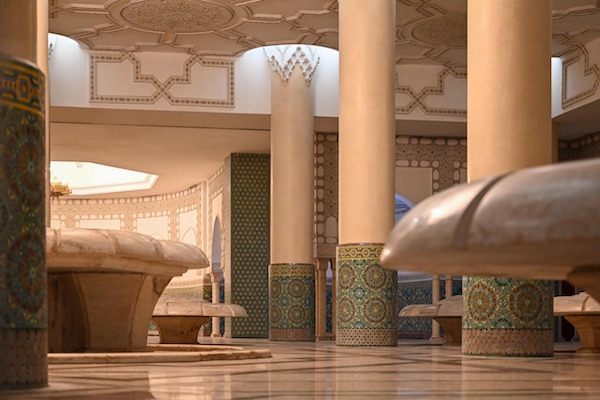Located in Abu Dhabi, the capital of the United Arab Emirates, Sheikh Zayed Grand Mosque is the largest mosque in the Gulf state and the eighth largest mosque in the world. It’s named after the late president HH Sheikh Zayed Bin Sultan Al-Nahayan, who is considered the father of the UAE and now burried at the mosque site.
Sheikh Zayed Grand Mosque is one of the most important contemporary architectural masterpieces of the Muslim world and one of the most beautiful landmarks of the UAE.
Although plans to build Sheikh Zayed Grand Mosque began in the late 1980s, the inaugural cornerstone was laid in the late 1990s after the completion of the initial architectural design.
Popularly called the Grand Mosque by local residents, the mosque’s main prayer halls were opened for the general public in Eid Al Adha in December 2007.
- “Unites the world”
The mosque’s initial architectural design was Moroccan, but it evolved to include global features to fulfil its aim as a construction that “unites the world”, using artisans and materials from Islamic and non-Islamic countries such as Italy, Germany, Morocco, India, Turkey, Iran, China, Greece and the United Arab Emirates.
At least 3,000 workers and 38 contracting firms participated in the construction of the 22,412 square metre mosque, which is approximately equivalent to the size of five football fields, and can accommodate upto 40,960 worshippers – 7,126 in the main prayer hall; 1,960 in the open prayer hall; 980 female worshippers in the open prayer hall female section; 22, 729 in the open Sahan (courtyard); 682 in the main prayer hall entrance and 784 in the mosque’s main hall entrance.
Natural materials have been used in the construction of the mosque- such as marble, stone, gold, semi-precious stones, crystals and ceramics, including 80 Iznikpanels – highly decorated ceramic tiles popular in the 16th century. The magnificent Iznikpanels, which can be found in Istanbul’s religious buildings, have been designed by Turkish calligrapher Othman Agha.
The mosque also features 28 different types of marble, including Sivec from Greece and Macedonia, Lasa from Italy, Makrana from India, Aquabiana and Biano from Italy and East White and Ming Green from China.
- World’s largest dome
Sheikh Zayed Grand Mosque boasts 82 domes of Moroccan design all decorated with white marble. According to the Turkey Research Centre for Islamic History and Culture, the mosque’s main dome is the largest of its kind, with height of 70 meters from the inside and 85 meters from the outside and an outer shell measuring 32.8 meters in diameters.
Four magnificent minarets of almost 107 meters stand at the mosque’s four corners. In the outer areas, there are 1,000 columns covered with at least 20,000 marble panels and semi-precious stones. The 96 columns in the main prayer hall are inlaid with mother of pearl. Reflective pools laden with dark tiles surround the Mosque to reflect its magical image.
The 17,000 square meter courtyard is decorated with white marble brought from Greece, adding additional glamour to the mosque’s breathtaking exterior.
The main glass door of the mosque is 12.2 metres high, 7 metres wide and weighs approximately 2.2 tonnes. Italian white marble and floral designs decorate the prayer halls, with the interior walls featuring gold-glass mosaic.
- World records
The Mosque’s main prayer hall features two valuable treasures that made new world records previously held by the Sultan Qaboos Grand Mosque in Oman; the world’s largest chandelier and largest hand-made carpet.
The chandelier, which is located under the main dome is 10 meters in diameter, 15 metres in height and weighs over nine tonnes. The mosque’s seven chandeliers, imported from Germany and valued at around U.S.$8.2 million, are made from gold-plated copper and fitted with Swarovski crystals from Austria and some glasswork from Italy.
Valued at U.S.$8.2 million, the mosque carpet laid out on the main prayer hall is designed by Iranian artist Ali Khaliqi and hand-knotted by 1,200 weavers, 20 technicians and 30 workers. Consisting of 2,268,000 knots, the world’s largest carpet measures 570 square feet and weighs around 47 tonnes.
The Mehrab (the niche found in the middle of the Qibla wall) in the main prayer hall is decorated with Gold-glass mosaic. The Qibla wall has been plainly decorated to avoid worshippers’ distraction. It features subtle fibre-optic lighting as well as the 99 names of Allah, designed by UAE calligrapher Mohammed Mandi, who, along with two other prominent calligrapher – Farouk Haddad (Syria) and Mohammed Allam (Jordan), designed the three different calligraphy styles of the Mosque; Naskhi, Thuloth and Kufi.
- Most visited
Thanks to its unique and magnificent architectural design, Sheikh Zayed Mosque is one of the most important tourist attractions in the city and the entire country.
Along with the Jumeirah Mosque in Dubai, Sheikh Zayed Grand Mosque is open to non-Muslims as part of the UAE’s commitment to promote religious and cultural understanding among people from different nations. The mosque’s library, located in the north minaret, holds classical books and rare publications dating back to more than 200 years and addressing a vast range of Islamic subjects, such as science, civilization, calligraphy and arts.
The mosque has been visited by Her Majesty Queen Elizabeth II and Prince Philip, the Duke of Edinburgh, in November 2010, and both praised the beauty of the Mmsque’s architecture, Islamic designs and calligraphy.
The Queen’s visit reflects the fact that the mosque is not just a house of worship, but rather a place of learning which can communicate the true meaning of Islam to others.
By: Dina Awadallah
Posted on: September 15, 2011

